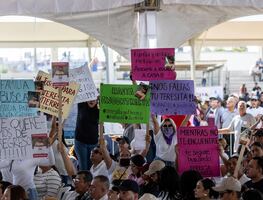Más Información

Osiel Cárdenas, exlíder del Cártel del Golfo, recibe auto de formal prisión; enfrentará juicio por homicidio

Jóvenes mexicanos pasan más de 2 mil horas al año en el teléfono; OCDE alerta sobre su impacto en la salud mental

Sergio Gutiérrez Luna destaca aprobación de 25 reformas en la 66 Legislatura; "Un logro histórico para la 4T", señala

Secretario de Agricultura reafirma defensa del maíz blanco; "Seguiremos apoyando la producción nacional no transgénica", afirma

¿Maíz transgénero? Rubén Rocha corrige desliz durante discurso en Sinaloa; destaca importancia del maíz blanco

Sheinbaum asegura apoyo total a Sinaloa para enfrentar violencia; "Nunca los vamos a dejar solos, aquí está la presidenta"
Mexican migration to the United States has dropped since 2008, but in 2014 it was surpassed by Central American migration for the first time in history.
Last year the Border Patrol arrested and deported 229,178 Mexicans and 257,473 Central Americans. Mexicans represented less than 47% of the total number of arrests for the first time.
Tucson has 20% of the Border Patrol agents deployed across the United States: 4,052 of a total of 20, 863 elements. Since 1998, it was the place where more undocumented Mexicans were arrested: 300,000 in that year compared to 68,870 in 2014. From that year on, San Diego and El Paso were used by less undocumented migrants due to the strengthened surveillance of the area, which led them to seek riskier and more inhospitable routes to enter the United States.
According to agent George L. Treviño, born in Matamoros, Tamaulipas, but nationalized American, most of undocumented immigrants are now arrested in McAllen, Texas, where 256,393 people were arrested in 2014. However, 75% of them were Central Americans.
Manuel Padilla Jr., head of the Border Patrol in Tucson, says that a record number of undocumented immigrants were arrested in 2000: 1.67 million: 1.63 million Mexicans and 39,555 of other nationalities. From that year on, the number of arrests started to decline and in 2011 it "bottomed out", with 340,252 cases (286,000 Mexicans and 54,098 of other nationalities). Last year 486,651 undocumented migrants were arrested, but 53% of them were Central Americans.
According to Treviño the drop is due to the "refinement" of technological resources, the increase in the number of Border Patrol agents and the changes in the immigration policy made since 2004, when the so-called "consequence system" was established.
Treviño explained that before 2004, migrants were arrested and returned to Mexico voluntarily. Now, every time a person is arrested, he/she is processed and fingerprinted.
"The first time a person is deported he/she can not apply for a visa for five years and the second time the period increases to 20 years. Recidivism can even lead to criminal charges. Before 2004, some times we arrested the same person two or three times in the same shift," he added.
Javier Urbano, coordinator of Migrant Affairs of the Iberoamerican University, says that the decline in Mexican migration is a result of tighter controls in the U.S. borderm and added that the increase in Central American arrests is due to the massive displacement generated by violence, poverty and exclusion, endemic in these countries.
"Mexicans are no longer going to another country, but to other states. The case San Quintín is an example," he added.
However, he warned that the trend could change if certain markets recover in the United States.
"The decline in migration is temporary and not structural. This labor continues to be an important part of the U.S. economy," Urbano said.




